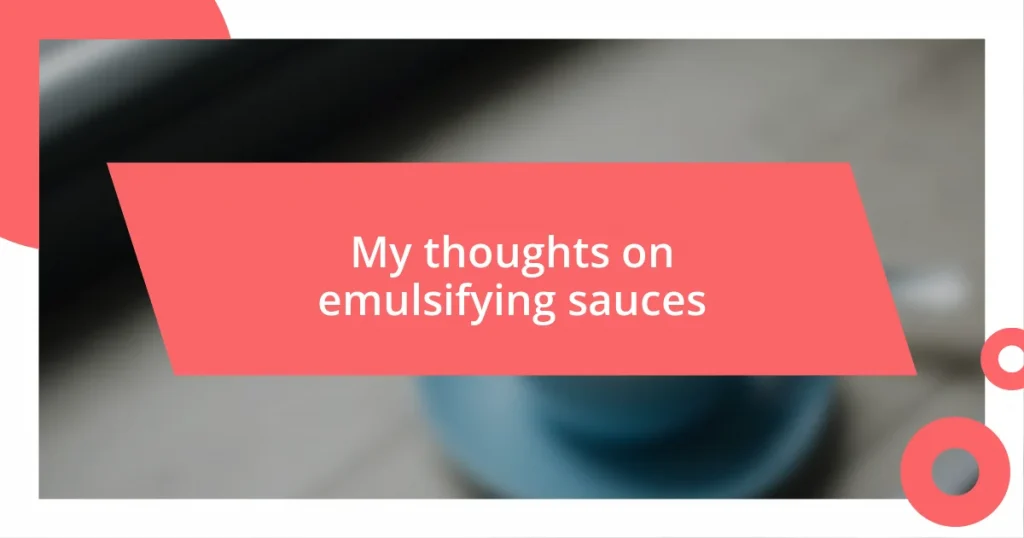Key takeaways:
- Emulsification combines immiscible liquids like oil and water, relying on emulsifiers (e.g., egg yolks) to create smooth, stable sauces.
- Emulsifying agents ensure sauce stability, enhance texture and mouthfeel, and promote harmonious flavor integration.
- Successful emulsification requires room temperature ingredients, gradual oil addition, and can benefit from creative applications beyond traditional uses.
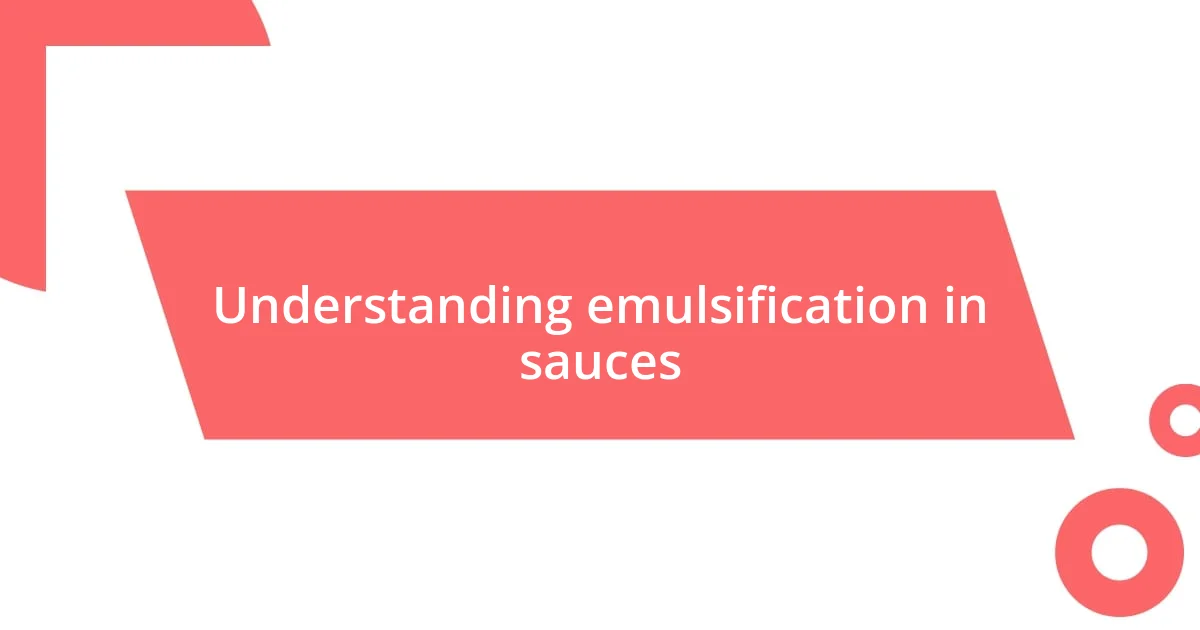
Understanding emulsification in sauces
Emulsification in sauces is a fascinating process where two immiscible liquids, typically oil and water, come together to create a smooth and stable mixture. I remember my first attempt at making a vinaigrette; I was skeptical about how whisking would blend the oil with vinegar, but it truly is a magical transformation! Have you ever experienced that moment of disbelief when your ingredients become something entirely new?
At its core, emulsification relies on an emulsifier, which is a compound that helps stabilize the mixture. For instance, egg yolks are commonly used in mayonnaise due to their natural emulsifying properties. I often marvel at how something so simple as an egg can turn a collection of ingredients into a rich and creamy sauce—it’s like having a culinary superpower!
When you think about it, emulsification goes beyond just technique; it’s about balance and harmony in flavors. I often ask myself, what makes a sauce truly delightful? The answer usually lies in how well the ingredients marry through emulsification, resulting in a velvety texture that enhances every bite. It’s like a beautiful dance of flavors that brings everything together on your palate, don’t you think?

Importance of emulsifying agents
Emulsifying agents play a crucial role in the culinary world, acting as the unsung heroes behind many of our favorite sauces. When I first started experimenting with sauces, I had no idea how much these agents could affect the final product. I recall nervously trying to create my first hollandaise sauce, and it dawned on me just how reliant it is on the emulsifier—egg yolk. Without it, I’d have ended up with a greasy mess rather than that luxurious, creamy sauce that’s so delightful over eggs.
The importance of emulsifying agents can be summarized in the following points:
- Stability: They help maintain a consistent texture and prevent separation, ensuring a smooth sauce that holds up beautifully over time.
- Texture: They contribute to the mouthfeel, providing that rich, creamy sensation that elevates the eating experience.
- Flavor Integration: By allowing the oil and water to mix, they enhance the overall flavor profile, marrying ingredients harmoniously.
Every time I whip up a sauce, I’m reminded of how reliant we are on these marvelous agents to bring everything together. It’s a blend of science and art that keeps me excited about cooking!
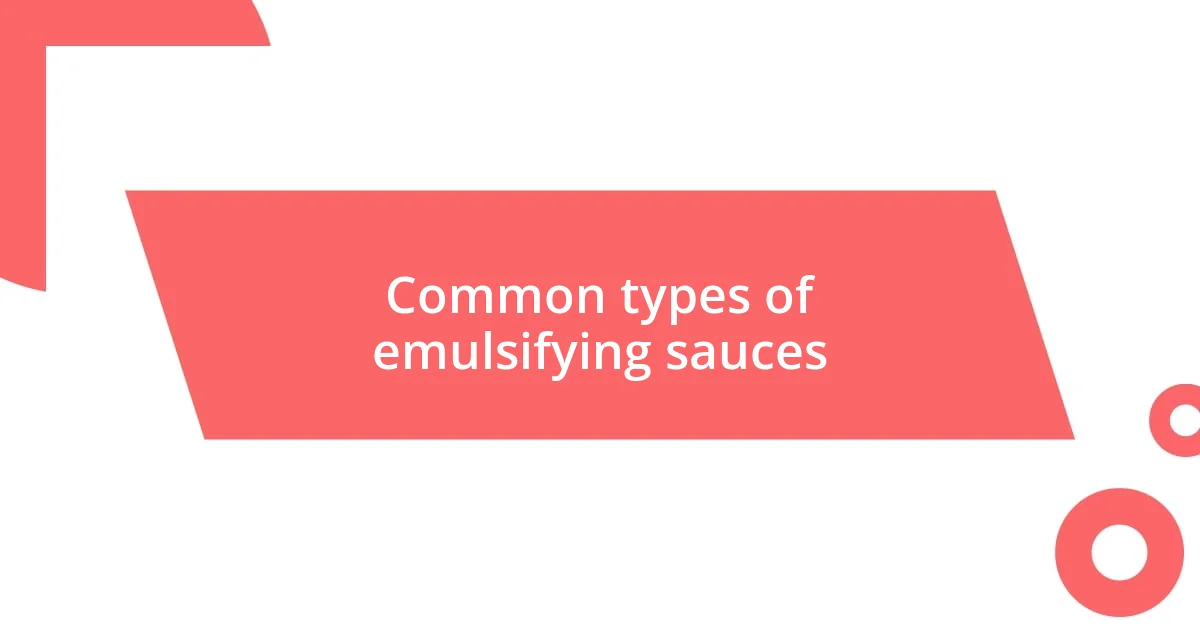
Common types of emulsifying sauces
Emulsifying sauces come in various forms, each with its own unique charm. For instance, mayonnaise is a classic example that never ceases to amaze me. I remember the first time I successfully whipped up a homemade batch; the transformation from simple ingredients into a creamy delight was so rewarding! You likely know that it relies on egg yolk, which acts as the emulsifier to bind the oil and vinegar together beautifully.
Another popular sauce is vinaigrette, which I often use as a versatile dressing. It’s fascinating how just a few ingredients—a combination of oil, vinegar, and perhaps a hint of mustard—can create such a dynamic flavor profile. I remember hosting a dinner party, and when I drizzled homemade vinaigrette over a salad, the vibrant colors and flavors brought the dish to life. It’s simplicity at its finest, with a splash of elegance, don’t you think?
Then there’s hollandaise, which has that rich, buttery flavor that elevates any dish. Making hollandaise for the first time was a whirlwind of emotions—I was nervous yet excited. As the warm butter and egg yolks came together, I felt a burst of joy when it thickened perfectly. It’s a sauce that requires careful attention, but the payoff is utterly delicious! Below is a comparison of these common emulsifying sauces to highlight their unique traits.
| Type | Main Ingredients |
|---|---|
| Mayonnaise | Egg yolk, oil, vinegar or lemon juice |
| Vinaigrette | Oil, vinegar, mustard (optional) |
| Hollandaise | Egg yolk, butter, lemon juice |
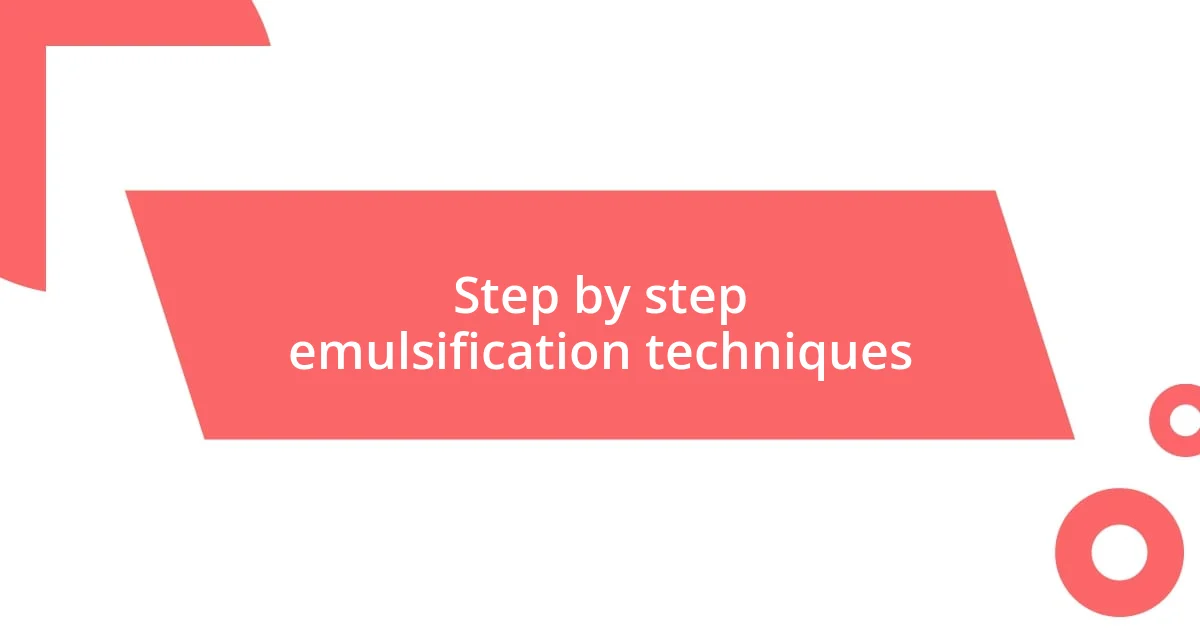
Step by step emulsification techniques
To emulsify, the first step is to ensure your emulsifying agent is prepared. When I whip up mayonnaise, I often start by whisking the egg yolk with a bit of mustard for that extra kick. It’s that vibrant, golden hue that gets me—it’s almost like a promise of what’s to come!
Once your base is ready, the next step involves slowly adding your oil. I learned the significance of this gradual approach the hard way during my early attempts when I joyfully dumped in the oil all at once and ended up with a split mess. Now, I take my time, drizzling the oil into the egg yolk mixture while whisking vigorously. It creates that magical emulsion, and I can practically feel the excitement build as the mixture thickens and transforms!
Don’t underestimate the power of patience and technique. I’ve found that as I continue whisking, it’s essential to keep the ingredients at a similar temperature. When I made hollandaise for the first time, I realized too late that separating the butter too soon gave me a grainy texture instead of that silkiness I craved. It’s a delicate dance, but once you master it, every sauce you create feels like a triumph! Have you ever felt that rush of excitement when you see your sauce come together perfectly? It’s moments like those that remind me why I love cooking so much.

Tips for successful emulsification
When it comes to emulsifying sauces, one of the best tips I can offer is to have everything at room temperature. I remember one time I was trying to make a vinaigrette, and I used cold olive oil straight from the fridge. The result? A non-emulsified mess that just wouldn’t come together. It dawned on me that temperature plays a vital role, and now I always let my ingredients settle to room temperature before diving into the mixing process.
Additionally, don’t be afraid to experiment with different emulsifying agents. As I began to explore making sauces, I discovered that experimenting with avocado, or even silken tofu for a creamy base, opened up a world of flavors and textures. Each addition brought its own unique charm, and I think about how liberating it was to step out of my comfort zone. What have you tried in your emulsification endeavors?
Lastly, steady hands and a light touch can make all the difference. During one of my kitchen adventures, I remember getting overly enthusiastic with my whisking while preparing hollandaise. It was a bit of a struggle to keep things balanced, which led to a less-than-smooth sauce. Now, I focus not just on the technique but also on taking a mindful approach to my movements, allowing for a gentle yet effective emulsification process. It’s all about finding that rhythm, don’t you think?

Troubleshooting emulsification issues
When I first encountered an emulsification failure, it took me by surprise. I had meticulously followed the steps for a homemade vinaigrette, only to wind up with an oily pool at the bottom of the bowl. In my frustration, I realized how crucial it is to whisk vigorously enough and ensure that the acid and oil are well-blended before adding more oil. Have you experienced a similar comeback moment in the kitchen?
Another time, I was making a classic béarnaise sauce, and it started to separate right in front of me. My heart sank, but I quickly learned that a splash of warm water can often revive a split sauce. It’s like having a secret weapon in your back pocket! The next time I faced this issue, I was calm and collected, and it felt rewarding to remedy what could have been a kitchen disaster.
Sometimes, I find that the simple act of switching my tools can yield better results. I used to rely heavily on my whisk, but I’ve discovered that using an immersion blender can work wonders, especially for thicker emulsions. Have you experimented with different utensils? It’s all about finding what resonates with your technique and enhances your emulsification experience.
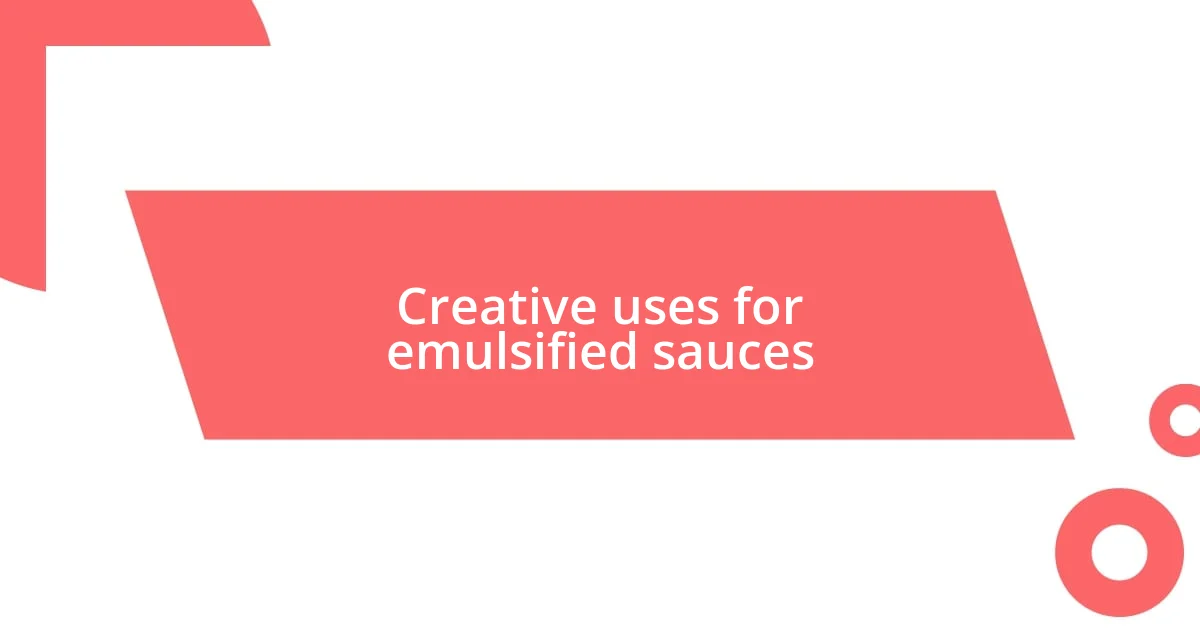
Creative uses for emulsified sauces
There are countless creative uses for emulsified sauces that can elevate your cooking in unexpected ways. For instance, the first time I drizzled a homemade green goddess dressing over grilled vegetables, it completely transformed the dish. The creamy texture paired with the smoky char of the veggies was an explosion of flavor that led me to declare, “Why didn’t I think of this sooner?” It’s a simple yet powerful reminder that an emulsified sauce can breathe new life into everyday meals.
Another fantastic option I’ve discovered is using emulsified sauces as a marinade or glaze. I had this lightbulb moment while prepping chicken for the grill; I decided to use a citrusy aioli as a marinade. Letting the chicken soak in that luscious sauce not only infused it with zesty flavors but also kept it incredibly moist. The results were so delicious that I found myself pondering: why limit these sauces to just salads and dips? Have you experimented with sauces in this way?
Don’t overlook the potential of emulsified sauces in baking either! One day, while trying to switch things up for a gathering, I used a tangy buttermilk ranch dressing in a savory muffin recipe. The unique flavor combined with the fluffy texture was such a delightful surprise that I felt like a culinary innovator. It left me with the thought: how often do we confine ourselves to the usual applications without exploring the creative boundaries of our favorite ingredients?










